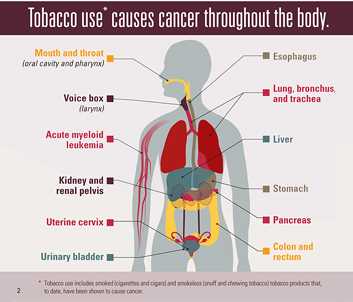Cancers linked to tobacco use make up 40% of all cancers diagnosed in the United States
Adult cigarette smoking is down, but tobacco use is still the most preventable cause of cancer
Press Release
Embargoed Until: Thursday, November 10, 2016, 1:00 p.m. ET
Contact: Media Relations
(404) 639-3286
Forty percent of cancers diagnosed in the U.S. may have a link to tobacco use, according to this month’s Vital Signs Report. Tobacco use is the leading preventable cause of cancer and cancer deaths. It causes more than lung cancer — based on current evidence, it can cause cancers of the mouth and throat, voice box, esophagus, stomach, kidney, pancreas, liver, bladder, cervix, colon and rectum, and a type of leukemia (acute myeloid leukemia).
Each year between 2009 and 2013, about 660,000 people in the U.S. were diagnosed with, and about 343,000 people died from, a cancer related to tobacco use, according to a new report by CDC. Three in ten cancer deaths were due to cigarette smoking, but progress has been made. Since 1990, about 1.3 million tobacco-related cancer deaths have been avoided.
“There are more than 36 million smokers in the U.S.,” said CDC Director Tom Frieden, M.D., M.P.H. “Sadly, nearly half could die prematurely from tobacco-related illnesses, including 6 million from cancer, unless we implement the programs that will help smokers quit.”
National Health Interview Survey (NHIS) data released today in a separate article in the same MMWR show that current cigarette smoking among U.S. adults declined from 20.9 percent (45.1 million) in 2005 to 15.1 percent (36.5 million) in 2015. During 2014-2015 alone, there was a 1.7 percentage point decline, resulting in the lowest prevalence of adult cigarette smoking since the CDC’s NHIS began collecting such data in 1965.
“When states invest in comprehensive cancer control programs—including tobacco control—we see greater benefits for everyone and fewer deaths from tobacco-related cancers. We have made progress, but our work is not done,” said Lisa C. Richardson, M.D., M.P.H., director of CDC’s Division of Cancer Prevention and Control.
Comprehensive cancer control programs are focused on reducing cancer risk, detecting cancer early, improving cancer treatments, helping more people survive cancer, improving cancer survivors’ quality of life, and better assisting communities disproportionately impacted by cancer. Comprehensive tobacco control programs coordinate efforts to implement proven strategies to prevent tobacco use initiation among youth and young adults, to promote tobacco users to quit, to eliminate secondhand smoke exposure, and to identify and eliminate tobacco-related disparities. However, not all states or all people have experienced the benefits of these efforts; tobacco prevention and control resources, along with access to medical care and cancer treatment, vary widely across the U.S. The Vital Signs report on tobacco-related cancers shows that:
- Incidence and death rates were highest among African-Americans compared with other races or ethnicities, people who live in counties with a low proportion of college graduates, and people who live in counties with high poverty levels.
- By region, incidence rates were highest in the Northeast (202 per 100,000 persons) and lowest in the West (170 per 100,000 persons).
- Incidence rates for tobacco-related cancers are still higher among men (250 per 100,000 persons) than women (148 per 100,000 persons).
Preventing and reducing tobacco use and tobacco-related cancers take comprehensive approaches
Quitting smoking at any age has health benefits, including reducing the risk of getting or dying from cancer. Quitting smoking improves the prognosis of cancer patients and reduces the risk of getting a secondary cancer (a cancer that occurs in a different organ) in cancer patients and cancer survivors.
States and communities can help by making quitting resources available to people who want them and by funding comprehensive tobacco prevention and control programs at CDC-recommended levels.
Smokers can get free help quitting by calling 1-800-QUIT-NOW. There they can get free counseling and information about the seven smoking cessation medications approved by the U.S. Food and Drug Administration. CDC’s Tips From Former Smokers campaign features real people living with the consequences of smoking-related diseases and offers additional quit resources at http://www.cdc.gov/tips, including cessation assistance developed by the National Cancer Institute at the National Institutes of Health.
The United States Cancer Statistics contains the official federal statistics on cancer incidence (newly diagnosed cases) from each registry that met data quality criteria. CDC and the National Cancer Institute have combined their cancer incidence data sources to produce these statistics. Mortality data are from CDC’s National Vital Statistics System. The CDC provides support for states and territories to maintain registries that provide high-quality data through the National Program of Cancer Registries.
- Page last reviewed: November 10, 2016
- Page last updated: November 10, 2016
- Content source:



 ShareCompartir
ShareCompartir
